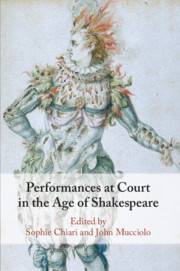15 results
Textual Note
-
- Book:
- Performances at Court in the Age of Shakespeare
- Published online:
- 31 October 2019
- Print publication:
- 24 October 2019, pp xvi-xvi
-
- Chapter
- Export citation
Contents
-
- Book:
- Performances at Court in the Age of Shakespeare
- Published online:
- 31 October 2019
- Print publication:
- 24 October 2019, pp vii-viii
-
- Chapter
- Export citation
Part III - Reassessing the Stuart Masque
-
- Book:
- Performances at Court in the Age of Shakespeare
- Published online:
- 31 October 2019
- Print publication:
- 24 October 2019, pp 135-190
-
- Chapter
- Export citation
Index
-
- Book:
- Performances at Court in the Age of Shakespeare
- Published online:
- 31 October 2019
- Print publication:
- 24 October 2019, pp 274-278
-
- Chapter
- Export citation
Part IV - The Material Conditions of Performances at Court
-
- Book:
- Performances at Court in the Age of Shakespeare
- Published online:
- 31 October 2019
- Print publication:
- 24 October 2019, pp 191-247
-
- Chapter
- Export citation
Part II - The Jacobean Tradition
-
- Book:
- Performances at Court in the Age of Shakespeare
- Published online:
- 31 October 2019
- Print publication:
- 24 October 2019, pp 77-134
-
- Chapter
- Export citation
Acknowledgements
-
- Book:
- Performances at Court in the Age of Shakespeare
- Published online:
- 31 October 2019
- Print publication:
- 24 October 2019, pp xv-xv
-
- Chapter
- Export citation
General Introduction
-
-
- Book:
- Performances at Court in the Age of Shakespeare
- Published online:
- 31 October 2019
- Print publication:
- 24 October 2019, pp 1-14
-
- Chapter
- Export citation

Performances at Court in the Age of Shakespeare
-
- Published online:
- 31 October 2019
- Print publication:
- 24 October 2019
Copyright page
-
- Book:
- Performances at Court in the Age of Shakespeare
- Published online:
- 31 October 2019
- Print publication:
- 24 October 2019, pp iv-iv
-
- Chapter
- Export citation
General Bibliography
-
- Book:
- Performances at Court in the Age of Shakespeare
- Published online:
- 31 October 2019
- Print publication:
- 24 October 2019, pp 248-273
-
- Chapter
- Export citation
Dedication
-
- Book:
- Performances at Court in the Age of Shakespeare
- Published online:
- 31 October 2019
- Print publication:
- 24 October 2019, pp v-vi
-
- Chapter
- Export citation
Illustrations
-
- Book:
- Performances at Court in the Age of Shakespeare
- Published online:
- 31 October 2019
- Print publication:
- 24 October 2019, pp ix-ix
-
- Chapter
- Export citation
Notes on Contributors
-
- Book:
- Performances at Court in the Age of Shakespeare
- Published online:
- 31 October 2019
- Print publication:
- 24 October 2019, pp x-xiv
-
- Chapter
- Export citation
Part I - Elizabethan Court Theatre
-
- Book:
- Performances at Court in the Age of Shakespeare
- Published online:
- 31 October 2019
- Print publication:
- 24 October 2019, pp 15-76
-
- Chapter
- Export citation



